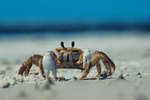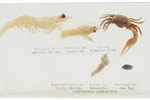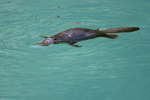
The blue crayfish is not a distinct species of crustacean but rather the result of a mutation of two different species of crayfish, the papershell crayfish (orconectes ommunis) and the Florida crayfish (Procambarus alleni). This mutation does occasionally happen naturally, but most often blue crayfish are created through selective breeding for the pet trade. These two species are native to distinctly different ranges in North America but are found in similar habitats and their life cycles are the same. Both have been widely imported to other areas by those who use them for bait or the pet trade.
Papershell Crayfish
The papershell, or calico, crayfish is native to Canada and the northeastern United States. They can be found in waters from southern Quebec and New England, as far west as the Dakotas and as far south as Tennessee. They live in the shallow waters of streams, creeks, ponds and even temporary waters such as large puddles and drainage ditches. When the puddles or ditches dry up the crayfish either burrow deep in the mud or move over land to other bodies of water. These crayfish also burrow deep to protect themselves from freezing temperatures during the winter months. They breed throughout the spring and summer. Their normal coloring is light to dark gray or brown.
Florida Crayfish
The Florida crayfish is only native to the peninsula of Florida and some of the Florida Keys. They are they most common type of crayfish found in the Everglades, where they thrive in the marshes and lakes. They also can be found in rivers, streams and ditches. Like the papershell crayfish, they burrow to protect themselves from dry conditions. Because of the warm climate they do not need to burrow during the winter months and they breed throughout the year. Their normal coloring is gray or brownish gray.
Feeding Habits
Both of these species of crayfish are opportunistic omnivores. They will eat just about anything they happen upon, including plants, snails, small fish and insect larvae, as well as any dead or decaying plants and animals. They do not hunt in the traditional sense but will use their large claws, found on their first set of legs, to grab at any creature that swims too close to them. Other than that, they use their smaller claws, on their second and third legs, to continuously search the ground around them for food.
Life Cycle
Like all crustaceans, the crayfish starts as an egg. The eggs are fertilized outside the female's body from sperm that was previously deposited in her seminal receptacle. Once fertilized, the eggs are glued to the female's legs and under belly with a sticky substance that she secretes. The eggs may take as long as 20 weeks to hatch, although under ideal conditions it takes only two to three weeks. Immediately after hatching the young crayfish molt but stay adhered to the mother's body. They will stay attached to her for another two to four weeks when they will molt a second time and set out on their own. The young do not grow quickly, it often takes two or three years before they reach sexual maturity.
References
Photo Credits
-
Jupiterimages/Photos.com/Getty Images
Writer Bio
Barbara Taliaferro is an animal enthusiast who lives in Ambler, Pa. She holds a Bachelor's Degree in Animal Science and has spent most of her life working with animals and the people who love them. She has been sharing her love and knowledge of animals through the written word since 2009.




